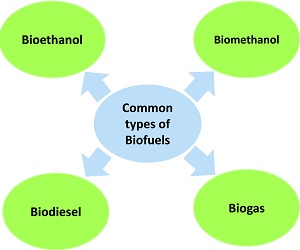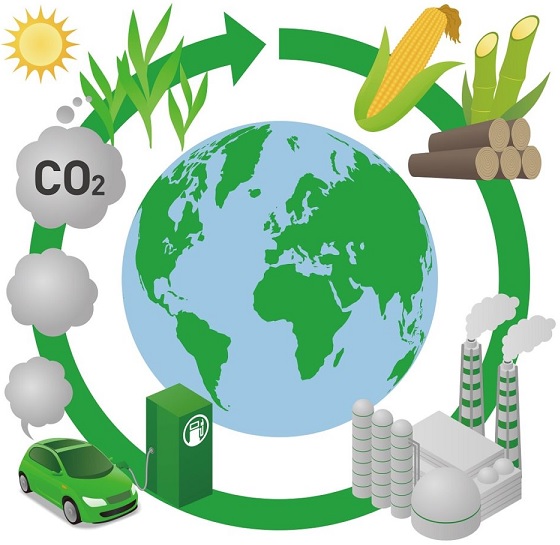The Benefits Of Producing Biofuels
Biofuels offer greener, and cleaner renewable energy options for our future. Biofuels are produced through the use of contemporary biological processes that include agricultural and anaerobic digestion. This invokes healthier, more earth friendly techniques than those fuels that are produced from geological processes involving the formation of fossil fuels like coal and petroleum, from prehistoric biological matter.
Cleaner and Greener Biofuel Products
Biofuels such as ethanol can be produced directly from plants, while other biofuels such as biodiesel can be produced indirectly from domestic, agricultural, commercial, and industrial waste.
5 Common Types of Biofuel Production
 Biofuels,
the fuel derived from biomass is made of plant and animal waste, and
are considered renewable energy sources. As a viable, cost-effective
alternative to fossil fuel they offer an environment friendly solution.
Biofuels,
the fuel derived from biomass is made of plant and animal waste, and
are considered renewable energy sources. As a viable, cost-effective
alternative to fossil fuel they offer an environment friendly solution.
Unlike other renewable energy sources, biomass can be converted directly into liquid fuels through contemporary processes rather than by the very slow geological processes involved in the formation of fossil fuels, such as oil and natural gas.
What is Biodiesel
Biodiesel is a renewable, biodegradable fuel manufactured domestically. Biodesel is the second most common liquid form of biofuel used in diesel engines. It is made from animal or vegetable oils which are sourced from animal fats or plants like palm, soybean, and sunflowers. Additionally used cooking oils can be used for producing biodesel. Biodiesel is a cleaner burning biofuel with the lower amount of pollution it releases when burned. It is commonly used to run machinery in factories and farms as well as diesel engine vehicles.
What is Biobutanol
Biobutanol offers the benefit of being the most promising biofuel alternative. Biobutanol is derived from bacteria and algae and continual global research aims to lower production cost and make it a viable option. It can be used as a substitute for gasoline without any alterations as a cleaner burning alternative that produces less greenhouse gases than gasoline.
What is Biogas
Biogas is produced by anaerobic digestion, a fermentation of organic matter in absence of oxygen. Organic matter used can be paper, wood, dried foliage, manure, municipal waste, certain plastics etc. Biogas burns easily with low pollution output making it a greener choice to use as fuel. In a compressed state it can used to power vehicles.
What is Biomethanol
Biomethanol can be produced by either gasification or pyrolysis, gasification produces higher amounts of biomethanol than pyrolysis. Biomethanol is considered an alternative energy source because of its high octane. Other advantages include low flammability, high performance, and low emissions. Methanol completely degrades into CO2 and water in the presence of steam so it is considered to be a safe for fuel cell–powered vehicles. M85 is a mixture of 85% methanol and 15% gasoline that can be used in existing vehicles without major technical modifications. Nakagawa et al, reported methanol production from forage grasses, trees, and crop residues like rice bran.
What is Ethanol
Ethanol, or bioalcohol, is made by fermentation of sugar and starch found in plants like sugarcane, corn, molasses and wheat, and is the most common liquid biofuel used across the world. Ethanol can be used as a substitute for gasoline in petrol engines. The commonly used form of ethanol used today is Gasohol, which is made by blending ethanol in proportion (generally 15%) with gasoline. Ethanol is considered to be more environmentally friendly due to its high octane and low carbon emission.

Renewable Biofuel Energy Derivatives
Renewable biofuels generally involve contemporary carbon fixation, such as those that occur in plants or microalgae through the process of photosynthesis. Other renewable biofuels are made through the use or conversion of biomass (referring to recently living organisms, most often referring to plants or plant-derived materials). This biomass can be converted to convenient energy containing substances in three different ways: thermal conversion, chemical conversion, and biochemical conversion. This biomass conversion can result in fuel in solid, liquid, or gas form. This new biomass can also be used directly for biofuels.
Bioethanol is an alcohol made by fermentation, mostly from carbohydrates produced in sugar or starch crops such as corn, sugarcane, or sweet sorghum. Cellulosic biomass, derived from non-food sources, such as trees and grasses, is also being developed as a feedstock for ethanol production. Ethanol can be used as a fuel for vehicles in its pure form, but it is usually used as a gasoline additive to increase octane and improve vehicle emissions. Bioethanol is widely used in the USA and in Brazil. Current plant design does not provide for converting the lignin portion of plant raw materials to fuel components by fermentation.
Biodiesel can be used as a fuel for vehicles in its pure form, but it is usually used as a diesel additive to reduce levels of particulates, carbon monoxide, and hydrocarbons from diesel-powered vehicles. Biodiesel is produced from oils or fats using transesterification and is the most common biofuel in Europe.
In 2010, worldwide biofuel production reached 105 billion liters (28 billion gallons US), up 17% from 2009, and biofuels provided 2.7% of the world's fuels for road transport, a contribution largely made up of ethanol and biodiesel.[citation needed] Global ethanol fuel production reached 86 billion liters (23 billion gallons US) in 2010, with the United States and Brazil as the world's top producers, accounting together for 90% of global production. The world's largest biodiesel producer is the European Union, accounting for 53% of all biodiesel production in 2010.[2] As of 2011, mandates for blending biofuels exist in 31 countries at the national level and in 29 states or provinces. The International Energy Agency has a goal for biofuels to meet more than a quarter of world demand for transportation fuels by 2050 to reduce dependence on petroleum and coal. The production of biofuels also led into a flourishing automotive industry, where by 2010, 79% of all cars produced in Brazil were made with a hybrid fuel system of bioethanol and gasoline.
